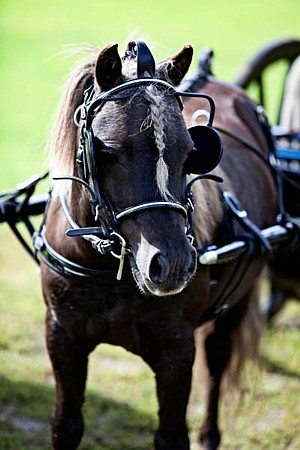We can get so wrapped up in expecting our driving horses to respond instantly, that we forget that a) abrupt changes of gait usually aren’t the prettiest changes of gait, and b) when we’re talking about a Miniature Horse pulling an adult driver, it can be unfair to expect immediate responses without a little heads up first.
From Whoa to Go
Imagine your horse is standing there like a good beastie, snoozing a bit, while you await the placings in the class, or chat with your friends, or wait your turn.
It’s time to move, so your first move is to tap your horse with the whip. I’m not saying you whack him – of course you don’t. But if he’s gone from relaxed standing and snoozing to a whip touch that means MOVE YOUR FEET NOW then it’s probably a pretty rude awakening and he’s going to jump, lunge forward, slip depending on the footing, and finally regain his balance and walk off, likely feeling a little uncertain and nervous with the sudden change in situation.
Instead, what if we simply took the very small amount of time it would take to pick up the reins, take some gentle contact, stay your horse’s name, and give a verbal cue “And WALK”. The result would be the same – your horse walks off. But from his point of view, it was a much more pleasant experience, with no surprises, and he’s balanced and ready to pick up another gait right away … say a pretty trot to go pick up your ribbon for example!
Transitions Matter
Next scenario: you’re driving in the show ring at a walk, and a trot is called for by the announcer, or you’re in a dressage test and the letter is coming up where you need to make a transition to the trot.
You could use sudden clucks and/or a whip tap to chase your horse into the trot. You’ll get the trot, but it might not be pretty, and it will probably take a few strides (or more than a few) to get your trot built into something you’re proud of.
Or, you can let your horse know what’s coming, and they’ll be able to rebalance and respond promptly and be ready for a higher level of performance right away.
Help them rebalance for the transition by checking in with your contact, breath, and say And TROT! – the rein cue, breath and “and” tell them that something is coming, and TROT tells them what to do next. Give them a second to step into the trot, and if you don’t get it right away, then you can follow up with a cluck or whip cue as needed. With repetition, you won’t need to follow up with anything, as they’ll be balanced and ready when you say TROT, much more willing to step into the new gait and ready to show a quality trot right out of the transition. And if you’re in that dressage test, you can start your cue sequence wherever you need to for your horse’s level of training, to get that trot exactly when his nose crosses the letter.
By helping your horse prepare for the trot, instead of suddenly chasing them into it, you’ll have a much better trot and a much happier horse.
Go to Whoa
One more example: You need to stop. Whether you’re coming up into the lineup at the end of your class at the big registry show, or halting at X at the end of your dressage test, a good whoa is a good whoa.
Often we see people stop so abruptly that their horse’s mouth pops open, they stop dead with legs splayed as they try to rock into the weight of the cart and stop it – harder when they’re in the show ring and probably don’t have breeching on. It was a prompt whoa, sure, but was it pretty? Or pleasant for your horse?
When we’re driving a Miniature Horse, the cart and driver routinely weighs as much as they do. They can handle that, sure, but why not make it as easy on them as we can? Not to mention prettier!
Same thing, let’s warn them. As you’re coming up to where you’d like to halt, start by giving a big slow breath (horses communicate with their breath a lot, so they’re very in tune with it – learn more here!), then a very drawn out aaaaannd and finally tell them whoa. With a little practice, you won’t need to do more with your hands than support them as they stop, which means you won’t be accidentally pulling them off balance. With a little warning they’ll be able to rebalance and slow the forward momentum of both themselves and the cart and be able to stop smoothly and in balance.
Communicating to our horse what’s coming is not only going to improve your horse’s performance, but it’s going to do wonders for their confidence and your relationship with your driving horse!

I love this blog post Kendra!! Preparation and communication is so so important for our little horses. Learning to have slower hands means so much to them as well. Thank you for bringing this to people’s attention!!